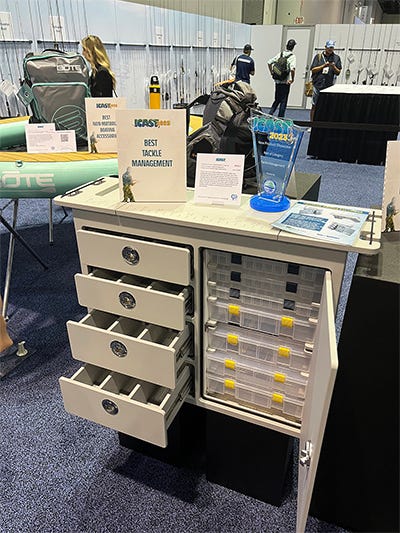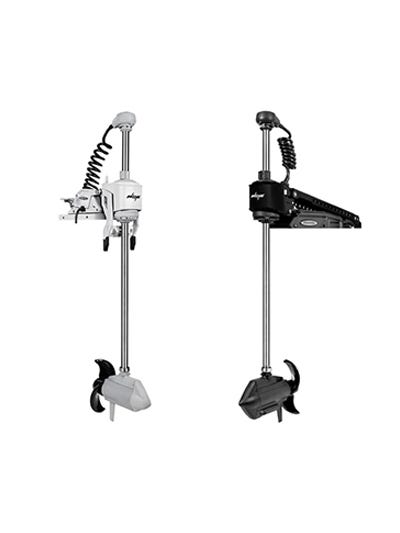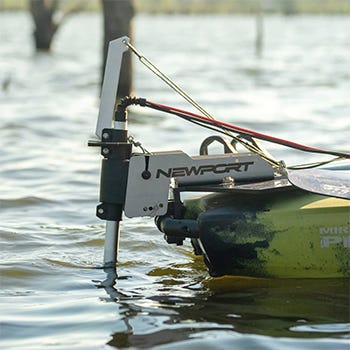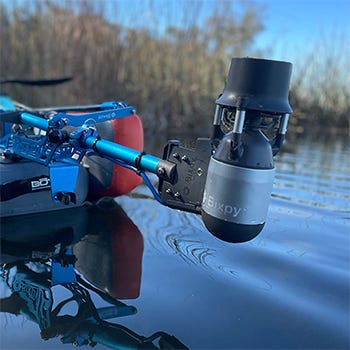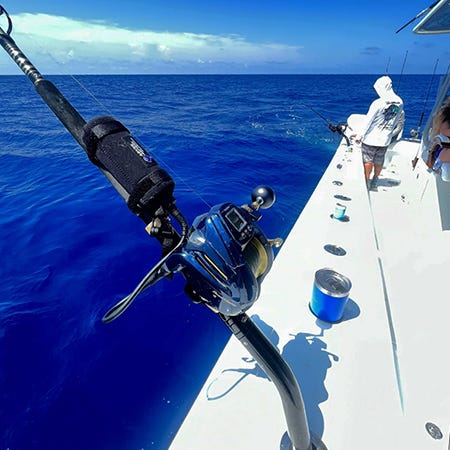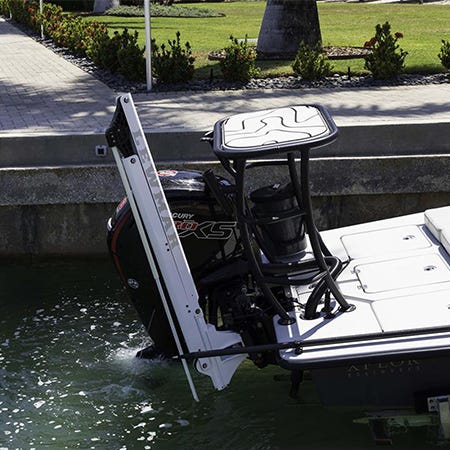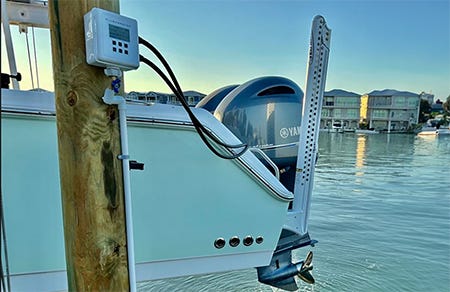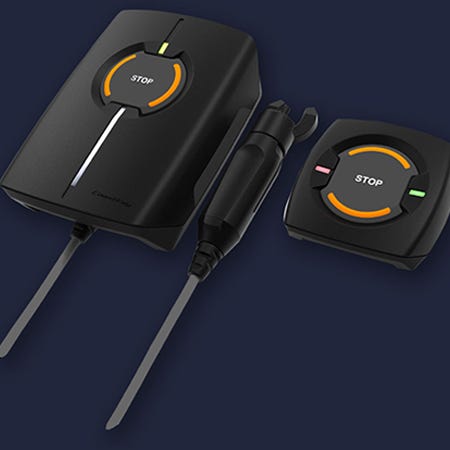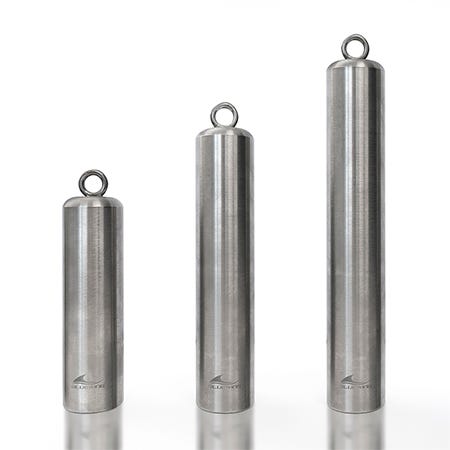

Although the International Convention of Allied Sportfishing Trades (ICAST) is first and foremost a trade show for the fishing industry, it’s also a great place to see new innovations in boats and boating. With that in mind, we walked the floor of the 2023 event in July looking for new and interesting boating accessories. Some of them won awards in the New Product Showcase (including our own Pontoon Tackle Storage Unit), while others just caught our eye as something new and interesting.
Contents
- 1. The Ultimate Pontoon Tackle Unit
- 2. Brushless Trolling Motors
- 3. New Kinds of Electric Propulsion
- 3.1 Navigating Modern Electric Motors
- 4. Lithium As Far As the Eye Can See
- 5. A New Entry into the Shallow Water Anchor Market
- 6. Automated Outboard Flushing
- 7. A Simple, Affordable Wireless Kill Switch
- 7.1 A New Product
- 8. And Finally, the World’s Most Expensive Sinker
The Ultimate Pontoon Tackle Unit
Winner of the Tackle Management Category in the New Product Showcase, Boat Outfitters’ new freestanding Pontoon Tackle Storage Unit packs incredible functionality into a compact footprint to turn virtually any pontoon into a fishing platform. It’s also lockable, meaning you can leave your tackle on board, and made from King Starboard, meaning it’s essentially impervious to moisture, UV and other environmental factors.
Even for pontoon owners who don’t carry enough tackle to fill the four drawers and seven trays, the additional space is ideal for keeping small items like sunscreen, keys, glasses, wallets, tools, utensils, documents and more secure and organized.
Our new bass boat Center Tackle Organizer was also featured in the Showcase. The Pontoon Tackle Unit is available in six different whites, grays and browns to coordinate with virtually any pontoon interior and retails for $2,434.


Brushless Trolling Motors
Brushless electric motors are more efficient, cooler-running, longer-lived and quieter than conventional brushed motors and are now widely used in battery-powered hand tools, yard tools, small appliances, etc. This technology has been available in trolling motors for a few years now, but only in freshwater models like the Lowrance Ghost. The past year, though, has seen the introduction of several brushless saltwater motors.
At ICAST, the biggest splash (literally and figuratively) was made by the much-anticipated Power-Pole Move 24/36 volt motors, which won the Motorized Boating Accessories Category in the New Product Showcase. Available with two different mounts in four different lengths from 45” to 72”, the Move has an MSRP of $5,000 to $5,600, depending on shaft length. Garmin’s new Force Kraken 24/36 volt brushless motors are available with 63”, 75” and 90” shafts for an MSRP of $3,900 to $4,300.
On the horizon are Minn Kota’s Riptide Instinct Quest and Riptide Terrova Quest, expected to be available in fall 2023. Both employ 24/36 volt brushless motors. Shaft lengths range from 60” to a monster 100".
Pricing for the auto-deploy Instinct ranges from $4,400 to $6,100. The manually deployed Terrova ranges from $3,800 to $5,500.
New Kinds of Electric Propulsion
Not all the electric motors at ICAST were trolling motors. There were also quite a number of small electric outboards and other not-easily classified electric propulsion devices.
The proliferation of lithium deep-cycle batteries — which are dramatically smaller and lighter relative to lead-acid batteries of equivalent capacity — has suddenly made it practical to power all kinds of small craft with electric motors. Of course, people have been using electric trolling motors for years to propel kayaks, Jon boats, and so on. But the ability to replace a pair of 12-volt, 65-lb. deep cycle batteries with a single 24-volt lithium battery that you can carry with one hand is game-changing, making electric power light enough even for SUPs.
Navigating Modern Electric Motors
Among the propulsion systems on display were outboard-style transom-mount motors like the Torqeedo Travel, Newport NT300, and ThrustMe Kicker, as well as stern-mounted, kayak-specific motors like the Newport NK300 and Torqeedo Ultralight, which connect to most kayaks’ existing cable steering systems.
The Bixpy K-1 takes a sort of modular approach. The motor and drive — which resemble the lower unit of a conventional trolling motor — can be paired with one of 20 or so different mounting adapters including through-hull mounts for several kayak brands, fin slot mounts for SUPs, and transom-mounted shafts with tiller steering.
The Texas Power Paddle, likewise, is a compact electric motor available with several different rudder- and transducer plate mounting systems for a number of kayak brands.
It seems clear that these propulsion systems are the forerunners of a new product category.
Lithium As Far As the Eye Can See
With the exception of soft and hard freshwater lures, there seemed to be no category better represented at ICAST than lithium batteries. The booths were everywhere — a dozen of them or more. And for good reason: for deep-cycle applications, lithium batteries are superior to flooded, AGM and gel batteries in nearly every way. They’re good for more cycles, can be discharged more deeply without damage, maintain their voltage longer into the discharge, charge faster, and weigh much less. The lone drawback is a big one, though: cost.
Still, it’s readily apparent that the revolution is underway. Lithium is clearly better, and, if history is any guide, prices will come down, just as they have on personal computers, flat screen televisions and so on.
By and large, the various battery companies’ monitoring apps seem to distinguish them from one another more than their actual batteries. But form factors are another area of differentiation, and Abyss Battery’s new electric reel battery stands out in that regard. Roughly cylindrical, seven-and-a-half inches in length and weighing just 1.6 lbs., this battery plugs directly into any electric reel and supplies plenty of power for a day’s deep-dropping or swordfishing. With an MSRP of $300, it’s also significantly less expensive than having a boat retrofitted with electric reel outlets.
A New Entry into the Shallow Water Anchor Market
Power-Pole has always been the 800-pound gorilla of powered shallow water anchors. Minn Kota introduced the Talon — an electric, telescoping design — in 2017 and then, in 2020, the Raptor — an articulating, hydraulic anchor similar to Power-Pole’s design. But Power-Pole has remained on top.
This year, Lewmar, an established U.K. company best known for windlassess, conventional anchors and sailboat hardware, released the Axis, the first electric articulating shallow water anchor. It deploys in essentially the same way as a Power-Pole, but Instead of using a hydraulic cylinder to extend, the Axis uses an electric motor.
That means there’s no hydraulic pump to install inside the boat and no hydraulic lines to route from the pump to the anchor. Instead, the Axis connects directly to 12V power.
The lack of hydraulic connections also makes the Axis relatively easy to remove from the transom when it’s not needed or when it would be in the way — while fishing offshore, for example, or towing kids on a tube. Just unplug the power cable and remove the two bolts holding the boat anchor to the transom bracket. The Axis is currently available only in an 8-foot model in either black or white. MSRP is $1,600.
Automated Outboard Flushing
The main reason outboards used in saltwater don’t get flushed as often as they should or for as long as they should is simply that it’s time-consuming. You’ve got other things to rinse, gear to put away and, hopefully, fish to clean. Plus, as long as your hose is hooked up to your engine, you can’t use it for anything else. Sure, in theory, you should be able to turn on the water, set a timer, go do something else, and then come back when the flushing is done. In practice, it doesn’t always work out that way, especially with two or more engines to flush.
The new Flushmaster system from Seamule automates the process. Essentially a sprinkler timer for your outboards, it flushes one engine at a time and then turns the water off when it’s done. The waterproof control box runs on plain AA batteries and can be plumbed into your dock water supply or even hooked straight to a garden hose and then mounted to a piling. Outlet hoses run from the box to each engine.
Flush time for each engine is user-programmable. You still can’t use your dock water for anything else while the Flushmaster is working, but the difference is that you can get all your other washdown chores done first, then hook up the Flushmaster, push the button and walk away.
The company is working on quick-connect fittings that can stay attached to your outboard flush port, saving still more time. MSRP is $300 for single and twin motors and $400 for triples and quads, including three-foot outlet hoses. Outlet hoses up to 20 feet are available at additional cost.
A Simple, Affordable Wireless Kill Switch
Both common sense and federal law dictate that boat operators actually use kill switch lanyards as opposed to just letting them dangle from the ignition key ring. But very few of us do for the simple reason that it’s a minor but frequent inconvenience. Every time you need to move more than a couple feet from the helm, you have to detach the lanyard from yourself and, more importantly, reattach it when you return. Not using your kill switch is irresponsible and dumb, but people are people.
Wireless options have been available for years, and they’re great. Instead of clipping the lanyard to yourself, you wear a small transmitter on your wrist or around your neck and move freely around the boat, but if you go overboard a “base station” wired into your ignition senses it and cuts the engines. The little pull-out kill switch next to your ignition is bypassed. The problem with these units — if you can call it a “problem” — is that installation can be a bit involved. You don’t have to be born a marine electronics tech, but you do have to do some cutting and connecting behind the dash.
A New Product
A new product from a Norwegian company called Nordic Wireless Solutions (the U.S. branch is called CoastKey and based in South Florida) does the same thing with zero wiring. It consists of a base station that connects via wire to your existing, manual kill switch — the same one you connect the curly red lanyard to — and a transmitter to be worn by the operator. The difference is that instead of having to be physically pulled away from the kill switch, the “jaws” on the CoastKey device snap open electronically to kill the engine(s) when the base station senses that you’ve gone overboard.
It consists of a base station that connects via wire to your existing, manual kill switch.
CoastKey has been around for years and is primarily known for a more complex wireless ignition system that allows you to both stop and start your engine(s) remotely and also functions as a MOB (man overboard) alert system and kill switch. As of mid-July 2023, the new kill switch is available for pre-order only. MSRP is a reasonable $239.
And Finally, the World’s Most Expensive Sinker
It’s tough to think of a sinker as eye-catching, but the new tungsten deep-drop weights from Bluewing Fishing are exactly that. With an attractive, silvery brushed finish and thick, well-made stainless steel attachment rings, the six-pound weight on display at ICAST was also remarkable for its diminutive stature. That’s because tungsten is 1.7 times heavier than lead.
So a six-pound tungsten weight is just a little over half the size of a six-pound lead weight. Smaller size means easier storage and, more importantly, less drag in the water, which translates to faster sinker and easier bottom-holding.
The catch? MSRP for the six-pounder is $600! The 10-pounder runs a cool $950. True story. Keep in mind, though, that gold is in fact slightly heavier by volume even than tungsten. Comparatively, tungsten weights are dirt-cheap.

